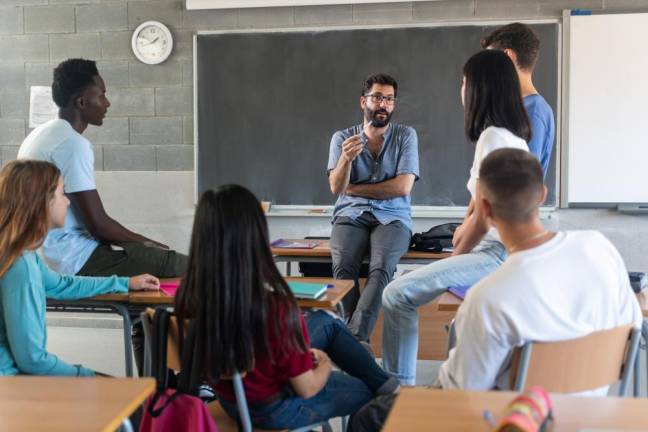In response to a reader survey of 127 parents, 85% said they believe their child has been bullied in school. 69% of those local parents said they reported the bullying to school administrators – but only 24% said were satisfied with the school’s response.
Districts, meanwhile, are being held accountable.
Just last month Rockaway Township School District in Morris County, N.J. agreed to pay $9.1 million to the family of Mallory Grossman, a 12-year-old who died by suicide in 2017 after being ostracized by her peers and repeatedly bullied online via Snapchat. The lawsuit accused the district of failing to protect Mallory despite multiple reports to administrators.
When it comes to bullying, schools “have a tremendous responsibility regardless of where the behavior occurred, whether it’s on site or online,” said Seamus Campbell, High Point Regional High School’s director of curriculum and instruction.
Anonymous tips, undercover ambassadors
Local districts are upping the ante to combat bullying – layering in tools and services to supplement traditional counseling and phone calls home.
The topic is folded into school curriculums. At Monroe-Woodbury Central School District anti-bullying programming starts in kindergarten. Delaware Valley School District (DVSD) addresses the issue in health class. The Delaware Valley curriculum tells kids what steps to take if they’re bullied, and also sends a message to potential aggressors to let them know the repercussions that come with adverse behavior.
“We try to frontload them with as much information as possible so they can make good choices when they are on their own,” said DVSD Superintendent Brian Blaum.
Multiple area schools, including High Point and Delaware Valley, set up anonymous tip lines that anyone can use to report bullying incidents or other serious threats.
DVSD has designated staff members to field and investigate those reports, but the system isn’t perfect.
“The anonymous piece is sometimes difficult when we hear ‘so-and-so is being bullied,’ and then we ask them, and they say they don’t know what’s going on,” said Blaum.
At Monroe-Woodbury, some middle school students quietly complete a “Safe School Ambassador” training program that aims to nip conflict in the bud.
“I don’t want to say there’s a secret training, but we try to keep them anonymous,” said Superintendent Elsie Rodriguez.
Working undercover, the ambassadors are taught to identify and diffuse conflict among peers. They then report incidents to administrators. “They let us know ahead of time that something is brewing,” said Rodriguez.
The next step is to bring in the students for peer mediation. “It works,” said Rodriguez. “And sometimes it doesn’t work.”
Repercussions
Schools turn to counseling services, as well as mediation “to get to the root of the problem,” said Rodriguez.
To start mediation at Monroe Woodbury, an administrator would talk to each student involved in bullying separately to find out who the key players are. Then the administrator would meet with all of the students together.
“What we see is that sometimes students don’t have the skill to be able to articulate what is the problem, so they resort to bullying, or cyberbullying or posting things that are inappropriate rather than address the issue,” added Rodriguez. “It’s all about helping our students understand and develop better communication skills.”
During the meeting, Rodriguez said everything is documented, and ground rules are set for everyone moving forward to stop further aggressions.
At DVSD, mediation is led by school counselors or fellow students trained through the high school’s peer mediation program.
“For some things that are just misunderstandings between kids, sometimes they’re more open with their peers than they are with an adult,” explained Blaum.
For instances that cannot be solved only through mediation, schools turn to traditional punitive responses. High Point Regional High School addresses a bullying incident the same way it does with any other Student Code of Conduct violation. Responses range from mediation, to detention and suspension. Aggressors’ schedules could be changed to remove them from a bullied student’s class, if necessary.
At DVSD, Blaum said schools encourage parents to get law enforcement involved in instances happening off school property. When the bullying affects a child’s learning or happens on school grounds, punishment depends on the severity of the bullying, but generally “starts with three days out of school suspension for a first offense,” said Blaum.
“If it’s chronic, and it’s dangerous and it’s violent,” students could be expelled, in Monroe-Woodbury, added Rodriguez.
New age of bullying
Rodriguez, Campbell and Blaum all agreed that social media fuels a majority of today’s bullying incidents.
“I’ve seen an increase in students doing things that they typically wouldn’t have done if they were face-to-face with another student,” said Rodriguez. “And I’m not just talking about children, right? What I’ve seen is there’s anonymity to Facebook or social media, people say things that they typically wouldn’t say in front of someone.”
“I can tell you that from the 20 years that I’ve been here, kids have fights...but when you are putting things out through social media, that has a lasting effect and sometimes, in my opinion, can be more detrimental to a student.”
